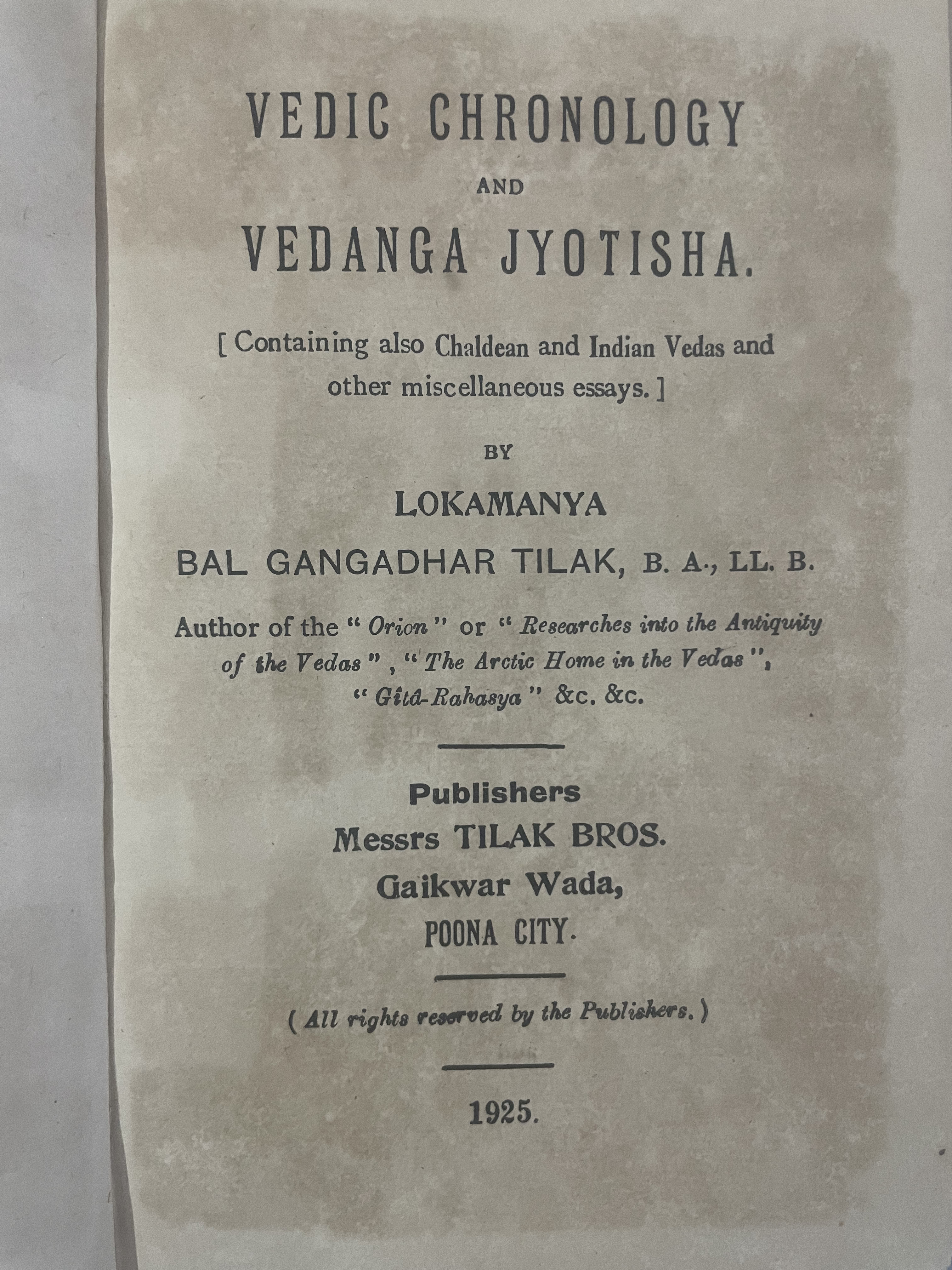Vedic Chronology and Vedanga Jyotisha

About
Summary
Exquisite
TOC
Details
Related
URL
Images
Overview
Vedic Chronology and Vedanga Jyotisha by Lokmanya Bal Gangadhar Tilak, published in 1925, explores the antiquity of the Vedas using astronomical calculations found in the Vedanga Jyotisha, an ancient Indian text on astronomy and astrology. Tilak, an Indian nationalist, scholar, and social reformer, aimed to establish a firm chronological framework for Vedic literature, challenging existing Western Indological theories.
Vedic Chronology and Vedanga Jyotisha delves into the complex relationship between Vedic literature and ancient Indian astronomy to determine the age of the Vedas. Tilak's approach combines textual analysis with astronomical data, particularly focusing on the positions of constellations and equinoxes described in Vedic texts.
Importance of Book
Challenging Colonial Indology: Tilak's work challenged the dominant Western Indological view of Indian history and culture, asserting the antiquity and originality of Indian civilization. His research aimed to counter the colonial narrative that portrayed India as a latecomer to civilization.
Promoting Nationalist Sentiment: Tilak's efforts to establish a firm chronological foundation for Vedic literature contributed to the rising tide of Indian nationalism. By highlighting the achievements of ancient Indian civilization, he sought to inspire pride and self-confidence among Indians.
Pioneering Interdisciplinary Approach: Tilak's book exemplifies an interdisciplinary approach to historical research, combining textual analysis with astronomical calculations and cultural context. This approach has influenced subsequent scholarship on ancient Indian history and astronomy.
Stimulating Further Research: Tilak's work stimulated further research on Vedic chronology and Indian astronomy. His theories have been debated and refined by subsequent scholars, leading to a deeper understanding of the subject.
Pride in Ancient Achievements: The book encouraged a sense of pride in ancient Indian achievements, highlighting the intellectual and scientific accomplishments of the Vedic period.
Reference Source: Tilak's work has remained a standard reference source on the subject.
Key Themes
The Antiquity of the Vedas: The central theme is the determination of the age of the Vedas, challenging conventional dating methods and asserting a much earlier origin.
The Interplay of Astronomy and Religion: The book highlights the close relationship between astronomy and religion in ancient India, demonstrating how astronomical knowledge was used to determine the timing of Vedic rituals.
Nationalism and Cultural Pride: Tilak's work reflects a strong sense of nationalism and cultural pride, seeking to reclaim India's past and assert its rightful place in world history.
Challenging Western Interpretations: The book critiques Western Indological interpretations of Indian history and culture, advocating for a more nuanced and culturally sensitive approach.
The Importance of Indigenous Knowledge: Tilak emphasizes the importance of understanding indigenous knowledge systems, such as Vedanga Jyotisha, for interpreting ancient texts and understanding Indian history.
A need to Recast History: This small treatise attempts to put things in proper perspective, endeavoring to sum up the whole controversy, thus recasting, revising, enlarging, and bringing up to date the theories that were readily accepted by scholars from all parts of the world.
Cultural Significance
Reassertion of Indian Identity: The book represents an attempt to reassert Indian cultural identity and challenge colonial narratives that denigrated Indian civilization.
Source of National Pride: It has become a source of national pride, inspiring Indians to appreciate their rich cultural heritage and intellectual achievements.
Influence on Historical Discourse: Tilak's work has influenced the discourse on ancient Indian history, prompting scholars to re-examine existing theories and methodologies.
Promotion of Indian Astronomy: The book has contributed to the promotion of Indian astronomy and its recognition as a sophisticated and ancient science.
Preserving and Promoting Vedic Knowledge: Tilak's work helps to preserve and promote Vedic knowledge, ensuring that future generations can learn about their rich heritage.
Effects on Society
Fueling Nationalist Sentiment: The book played a role in fueling nationalist sentiment during the Indian independence movement, inspiring pride in India's ancient past.
Inspiring Further Research: Tilak's work inspired further research on Indian history, astronomy, and culture, leading to a deeper understanding of India's past.
Promoting the Study of Sanskrit and Vedic Texts: The book encouraged the study of Sanskrit and Vedic texts, helping to preserve and transmit this knowledge to future generations.
Contributing to the Development of Indian Historiography: Tilak's approach to historical research contributed to the development of a more independent and culturally sensitive Indian historiography.
Influence on Cultural and Educational Institutions: The book may have influenced the curriculum of cultural and educational institutions, promoting a greater emphasis on Indian history and culture.
Conclusion
Vedic Chronology and Vedanga Jyotisha by Lokmanya Bal Gangadhar Tilak is a seminal work that attempts to establish the antiquity of the Vedas using astronomical calculations found in the Vedanga Jyotisha. The book's importance lies in its challenge to colonial Indology, its promotion of nationalist sentiment, and its interdisciplinary approach to historical research. Its key themes include the antiquity of the Vedas, the interplay of astronomy and religion, and the assertion of Indian cultural identity. Its cultural significance stems from its reassertion of Indian pride and its contribution to the preservation of Vedic knowledge. The book has had a lasting effect on country and society, fueling nationalist sentiment, inspiring further research, and contributing to the development of Indian historiography.
Title
Vedic Chronology and Vedanga Jyotisha
Author
Lokmanya Balgangadhar Tilak
Name of Publisher
Tilak bros Poona city
Publish Date
1925
Subject
The ancient Vedic texts
Vintage
1901-1947
Number of Pages
174
Category
Religion/Spirituality
Sub Category
Hindu Studies
Rarity
RARE
